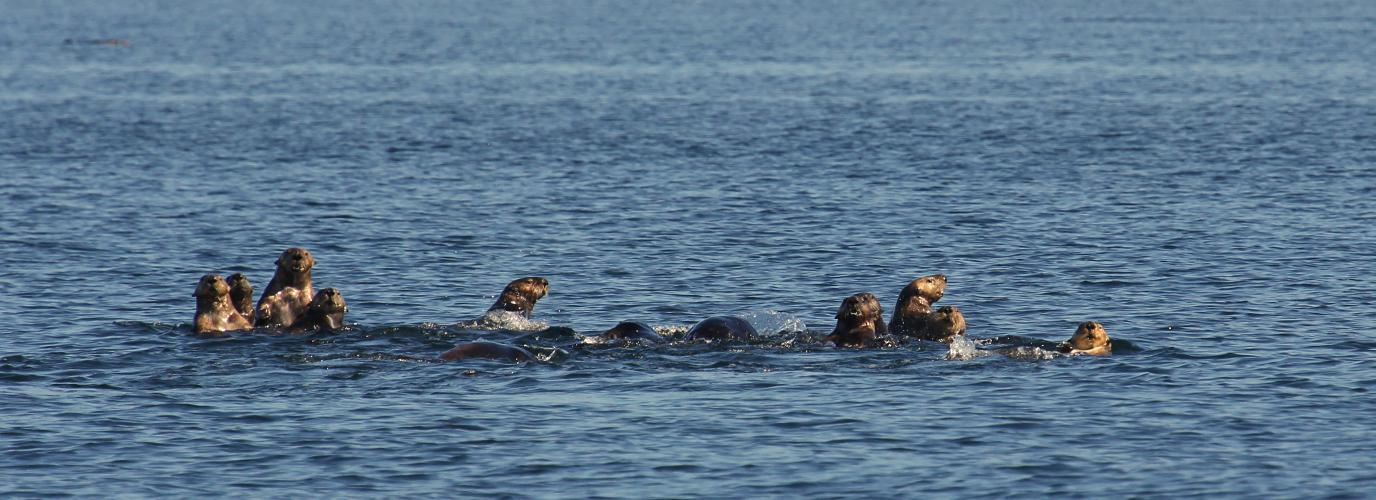A Furry Treasure Trove of Information
We can learn a great deal from one animal’s untimely demise.

With fifty kilometers of coastline facing the open Pacific Ocean, all sorts of things wash up on Calvert Island. Japanese tsunami debris. Millions of jellyfish. Glass fishing floats. Tangled clumps of kelp. But in late June, an unexpected ball of fur washed up that had Hakai scientists excited.
BC Parks’ Bree Mathewman and Rob Nelson were doing a regular trail check in the Hakai Lúxvbálís Conservancy when they spotted something at the far end of the Calvert Island trail system, a 45-minute hike over undulating terrain from Hakai’s Calvert Island Field Station.
“They told me there was a dead sea otter on Seventh Beach and that the tide was coming up, so if we wanted to collect it we’d have to run,” says Hakai researcher Erin Rechsteiner. She monitors sea otters in the seas around the institute, but she had fortuitously returned early from that day’s otter survey due to bad weather.
Owing to its plethora of fjords and islands, British Columbia has 25,725 kilometers of coast. That’s about as much as Australia. Most of this coast lies far from population centers and is only accessible by boat.

This means that vultures, wolves, and bears scavenge most dead marine mammals that wash up on the shore long before any human would come across them. And yet here was this sea otter—dead for less than a day with no obvious injuries on its German shepherd-sized body—washed up in an accessible location near Hakai’s Calvert Island Field Station.
“The otter was really heavy, and the water was lapping at it when we got there, so we built it a driftwood sled and tied it on,” says Rechsteiner. “We carried it kind of like a stretcher up the hills. He was just coming out of rigor. Trying to carry 90 pounds [40 kilograms] of floppiness up a steep trail is really hard to do.”
Scrambling with fellow scientists and Hakai staff, Rechsteiner and colleagues managed to get the otter back to the research station to take samples and prepare the carcass to be sent for a necropsy (an animal autopsy).*
Back in the lab, four sea otter biologists who happened to be in residence that day—including Fisheries and Oceans Canada marine mammal scientist Linda Nichol, as well as sea otter researchers Michelle Staedler and Jessica Fujii from the Monterey Aquarium—took a closer look.
“Two of his teeth were broken. It felt like there was a big infection near the tooth,” says Rechsteiner, who noted that tooth infections are a common natural cause of death for carnivores like sea otters.

What’s more, Rechsteiner recognized the otter lying on the lab table. He was a blonde male with an unmistakable nose scar that she had watched feed off West Beach, a mere five-minute walk from the research station, a couple of years before he washed up.
From one animal’s death, we can learn all sorts of details about its life. Chemicals in his whiskers can be analyzed to see how his feeding habits changed over the years. Rings in his teeth can be counted, like a tree, to determine his age.
A sample of his luxuriant fur, the softest in the animal kingdom, yields his genetics. Using a variety of techniques, the whole life of one otter can be pieced together. This particular otter can also help unravel the mystery of his sea otter compatriots, the group Hakai researchers have been monitoring intensively since 2013.
Sea otters were wiped out in British Columbia during the 19th century European fur trade. Over thirty years ago, a group of sea otters was found 35 kilometers northwest of Calvert Island. This BC Central Coast population, currently about 1,000 individuals, has been slowly expanding their range ever since.
Through genetics, we can find out whether the Central Coast otters were fur trade remnants, or drifters from Vancouver Island or Southeast Alaska where sea otters were reintroduced in the 1960s and 70s.
For now, Rechsteiner and her colleagues will have to wait. The necropsy, carried out by Stephen Raverty from the BC Ministry of Agriculture, should be able to determine if the infected tooth indeed caused the otter’s demise. The whisker and genetics samples will take a while to process.
“Other than the tooth, he looked really healthy. He had a lot of fat. He was heavy. Looked like he’d never missed a meal in his life. Carrying him all that way, we were pretty sore the next day,” says Rechsteiner.
His death could’ve easily gone unnoticed, yet owing to his serendipitous resting place, what we learn about his life will be this sea otter’s legacy.
*Sea otters are listed as a Species of Special Concern under the Species at Risk Act in Canada. This sea otter was handled by trained professionals under possession permit number RR 16-0247 from Fisheries and Oceans Canada.

